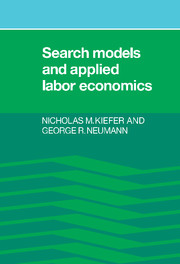Book contents
- Frontmatter
- Contents
- Preface
- 1 Introduction
- Part I Wages, reservation wages, and duration
- Part II Continuous-time models of duration
- 5 Earnings, unemployment, and the allocation of time over time
- 6 Choice or chance? A structural interpretation of individual labor market histories
- 7 Layoffs and duration dependence in a model of turnover
- Part III Applications
- Part IV Mobility and contracting
- Index
5 - Earnings, unemployment, and the allocation of time over time
Published online by Cambridge University Press: 06 October 2009
- Frontmatter
- Contents
- Preface
- 1 Introduction
- Part I Wages, reservation wages, and duration
- Part II Continuous-time models of duration
- 5 Earnings, unemployment, and the allocation of time over time
- 6 Choice or chance? A structural interpretation of individual labor market histories
- 7 Layoffs and duration dependence in a model of turnover
- Part III Applications
- Part IV Mobility and contracting
- Index
Summary
Introduction
In this study we consider a dynamic model of an individual's allocation of time among the three labour market states employment, unemployment, and nonparticipation. In this model individuals respond in a rational manner to shocks that occur to them from time to time. The optimal strategy of an individual in the assumed environment will imply that his movement among the labour market states can be represented by a Markov chain. The Markovian implications of the theory are studied and the crucial assumptions are identified. The effects of different expected wages on the transition rates are studied in some detail.
Since an individual's labour market history can be described by a Markov chain in state space, it is possible to calculate the steady states. It is natural to interpret the steady state proportion in unemployment for a group of identical workers as the natural rate of unemployment for this group, i.e. it is the expected proportion that would be employed if the environment were to remain constant. It is shown how the natural rate of unemployment is different for different groups. The model is estimated using data from a large U.S. income maintenance experiment. The predictions of the model, with some exceptions, bear up well to confrontation by data.
The empirical findings also accord well with existing evidence on cross section studies of labour supply.
- Type
- Chapter
- Information
- Search Models and Applied Labor Economics , pp. 83 - 108Publisher: Cambridge University PressPrint publication year: 1989



